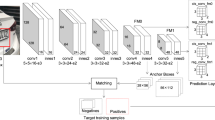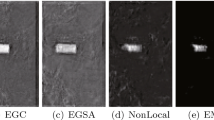Abstract
Conventional computer vision systems detect object after super-resolution (SR) or image reconstruction of the whole image, which is not an economical manner. By imitating the visual system of human beings, we proposed the bionic vision system (BVS), which is mainly composed by three parts: object detection by visual attention model, object-oriented SR reconstruction and object recognition by convolutional neural networks. The visual attention model contains both bottom-up and top-down cues. The bottom-up cues integrate low-level features by the feature integration theory. An Adaboost detector imitates the top-down cues. Sparse coding and compressed sensing reconstruction realize the object-oriented SR reconstruction. The BVS was validated on license plate recognition task. Both detection performance and SR reconstruction performance are tested. Besides of these, we also test the final recognition rate, all the experimental results are quite encouraging.









Similar content being viewed by others
References
Anagnostopoulos C, Anagnostopoulos I, Psoroulas I, Loumos V, Kayafas E (2008) License plate recognition from still images and video sequences: a survey. IEEE Trans Intell Transp Syst 9(3):377–391
Berinde R (2009) Advances in sparse signal recovery methods. PhD thesis, Massachusetts Institute of Technology
Bruce N, Tsotsos J (2009) Saliency, attention, and visual search: an information theoretic approach. J Vis 9(3):1–24
Candes E, Tao T (2005) Decoding by linear programming. IEEE Trans Inf Theory 51(12):4203–4215
Candès E, Romberg J, Tao T (2006) Robust uncertainty principles: exact signal reconstruction from highly incomplete frequency information. IEEE Trans Inf Theory 52(2):489–509
Canosa R (2009) Real-world vision: selective perception and task. ACM Trans Appl Percept 6(2):1–34
Carlson E, Rasquinha R, Zhang K, Connor C (2011) A sparse object coding scheme in area v4. Curr Biol 21(4):288–293
Denil M, Bazzani L, Larochelle H, de Freitas N (2012) Learning where to attend with deep architectures for image tracking. Neural Comput 24(8):2151–2184
Donoho D (2006) Compressed sensing. IEEE Trans Inf Theory 52(4):1289–1306
Edelman S (1995) Receptive fields for vision: from hyperacuity to object recognition. Tech. rep., Jerusalem, Israel
Foldiák P, Young M (1998) Sparse coding in the primate cortex. In: Arbib MA (ed) The handbook of brain theory and neural networks. MIT Press, Cambridge, pp 895–898
Freeman W, Pasztor E, Carmichael O (2000) Learning low-level vision. Int J Comput Vis 40(1):25–47
Frintrop S (2006) VOCUS: a visual attention system for object detection and goal-directed search. Springer, New York
Gao Yang LY, Ke Z (2006) Application of human vision bion ics in detection, estimation and tracking for photoelectr ic target. Aero Weapon 001:22–25
Glasner D, Bagon S, Irani M (2009) Super-resolution from a single image. In: 2009 IEEE 12th international conference on computer vision. IEEE, pp 349–356
Hanton K, Sunde J, Butavicius M, Burns N (2010) Super-resolution of infrared images: Does it improve operator object detection performance? J Comput Inf Technol 18(2):141–150
Huang G, Liu Z, Van Der Maaten L, Weinberger KQ (2017) Densely connected convolutional networks. In: CVPR, vol 1, p 3
Itti L, Baldi P (2009) Bayesian surprise attracts human attention. Vis Res 49(10):1295–1306
Itti L, Koch C, Niebur E et al (1998) A model of saliency-based visual attention for rapid scene analysis. IEEE Trans Pattern Anal Mach Intell 20(11):1254–1259
Kim K, Kwon Y (2010) Single-image super-resolution using sparse regression and natural image prior. IEEE Trans Pattern Anal Mach Intell 32(6):1127–1133
Kim J, Kwon Lee J, Mu Lee K (2016) Accurate image super-resolution using very deep convolutional networks. In: Proceedings of the IEEE conference on computer vision and pattern recognition, pp 1646–1654
Koch C, Ullman S (1985) Shifts in selective visual attention: towards the underlying neural circuitry. Hum Neurobiol 4(4):219–227
Koschan A, Abidi M (2008) Digital color image processing. Wiley, New York
LeCun Y, Bottou L, Bengio Y, Haffner P (1998) Gradient-based learning applied to document recognition. Proc IEEE 86(11):2278–2324
Ledig C, Theis L, Huszar F, Caballero J, Cunningham A, Acosta A, Aitken A, Tejani A, Totz J, Wang Z (2017) Photo-realistic single image super-resolution using a generative adversarial network. In: 2017 IEEE conference on computer vision and pattern recognition (CVPR). IEEE, pp 4681–4690
Lee H, Battle A, Raina R, Ng A (2007) Efficient sparse coding algorithms. Adv Neural Inf Process Syst 19:801–808
Milanese R, Wechsler H, Gil S, Bost J, Pun T, Geneva S (1994) Integration of bottom-up and top-down cues for visual attention using non-linear relaxation. In: Proceedings of the IEEE conference on computer vision and pattern recognition, Citeseer, pp 1–5
Mnih V, Heess N, Graves A et al (2014) Recurrent models of visual attention. In: Advances in neural information processing systems, pp 2204–2212
Nasrollahi K, Moeslund TB (2014) Super-resolution: a comprehensive survey. Mach Vis Appl 25(6):1423–1468
Olshausen B, Field D (1997) Sparse coding with an overcomplete basis set: a strategy employed by v1? Vis Res 37(23):3311–3325
Simard PY, Steinkraus D, Platt JC (2003) Best practices for convolutional neural networks applied to visual document analysis. In: 2013 12th International conference on document analysis and recognition, vol 2. IEEE Computer Society, pp 958–958
Treisman A, Gelade G (1980) A feature-integration theory of attention. Cogn Psychol 12(1):97–136
Viola P, Jones M (2001) Rapid object detection using a boosted cascade of simple features. In: IEEE computer society conference on computer vision and pattern recognition (CVPR), pp 511–519
Wolfe J, Horowitz T (2004) What attributes guide the deployment of visual attention and how do they do it? Nature Rev Neurosci 5(6):495–501
Yang J, Wright J, Huang T, Ma Y (2010) Image super-resolution via sparse representation. IEEE Trans Image Process 19(11):2861–2873
Yao Z, Yi W (2012) License plate location based on improved visual attention model. In: Fourth international conference on machine vision (ICMV 2011): machine vision, image processing, and pattern analysis, international society for optics and photonics, vol 8349, p 834916
Yao Z, Yi W (2014) License plate detection based on multistage information fusion. Inf Fusion 18:78–85
Zhang L, Pan F (2002) A new method of images super-resolution restoration by neural networks. In: Proceedings of the 9th international conference on neural information processing, 2002 (ICONIP’02), vol 5. IEEE, pp 2414–2418
Zhao S, Peng S (2003) Wavelet-domain hmt-based image superresolution. J Comput Aided Des Comput Graph 15(11):1347–1352 (in Chinese)
Acknowledgements
This work was supported by grants partly from the Key Projects in the National Science & Technology Pillar Program during the 12th Five-Year Plan Period (No. 2012BAJ24B01-5), and One Hundred Talents Project of The Chinese Academy of Sciences (No. 99M2008M02).
Author information
Authors and Affiliations
Corresponding author
Additional information
Publisher's Note
Springer Nature remains neutral with regard to jurisdictional claims in published maps and institutional affiliations.
Rights and permissions
About this article
Cite this article
Yao, Z., Yi, W. Bionic vision system and its application in license plate recognition. Nat Comput 19, 199–209 (2020). https://doi.org/10.1007/s11047-019-09746-6
Published:
Issue Date:
DOI: https://doi.org/10.1007/s11047-019-09746-6




